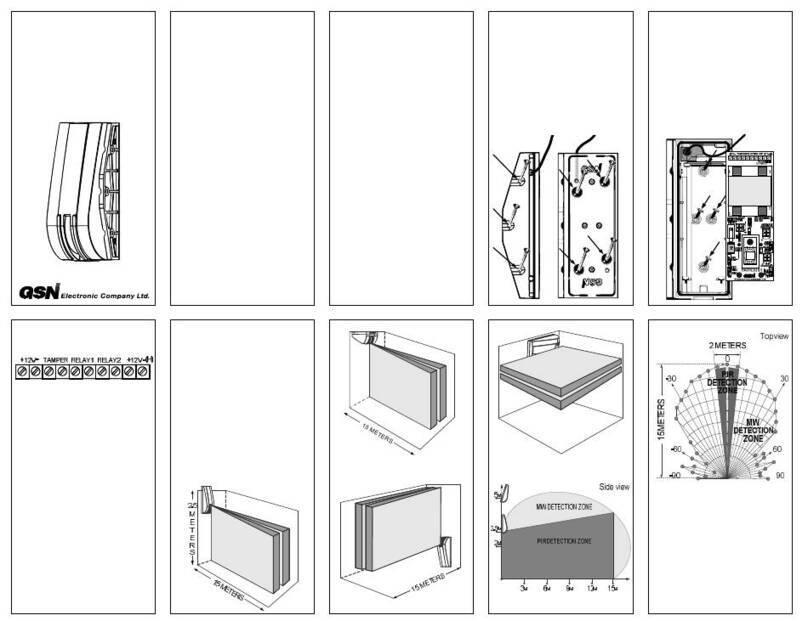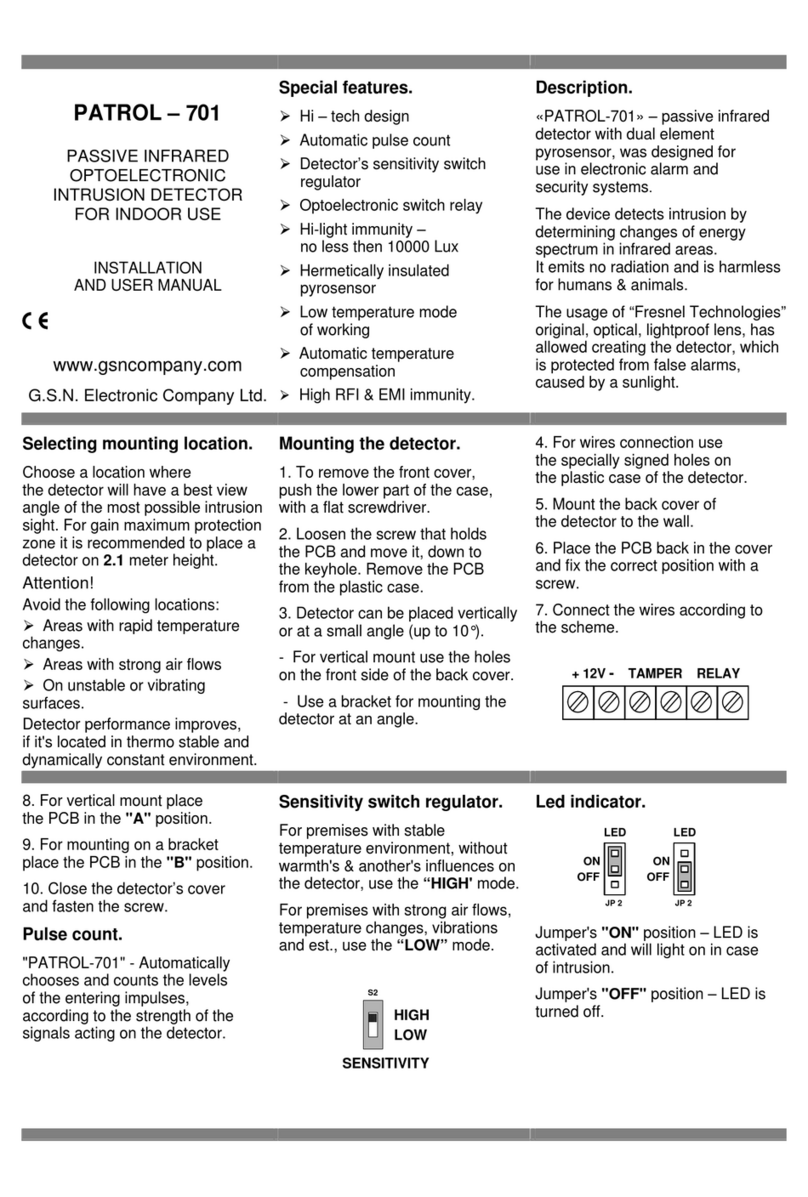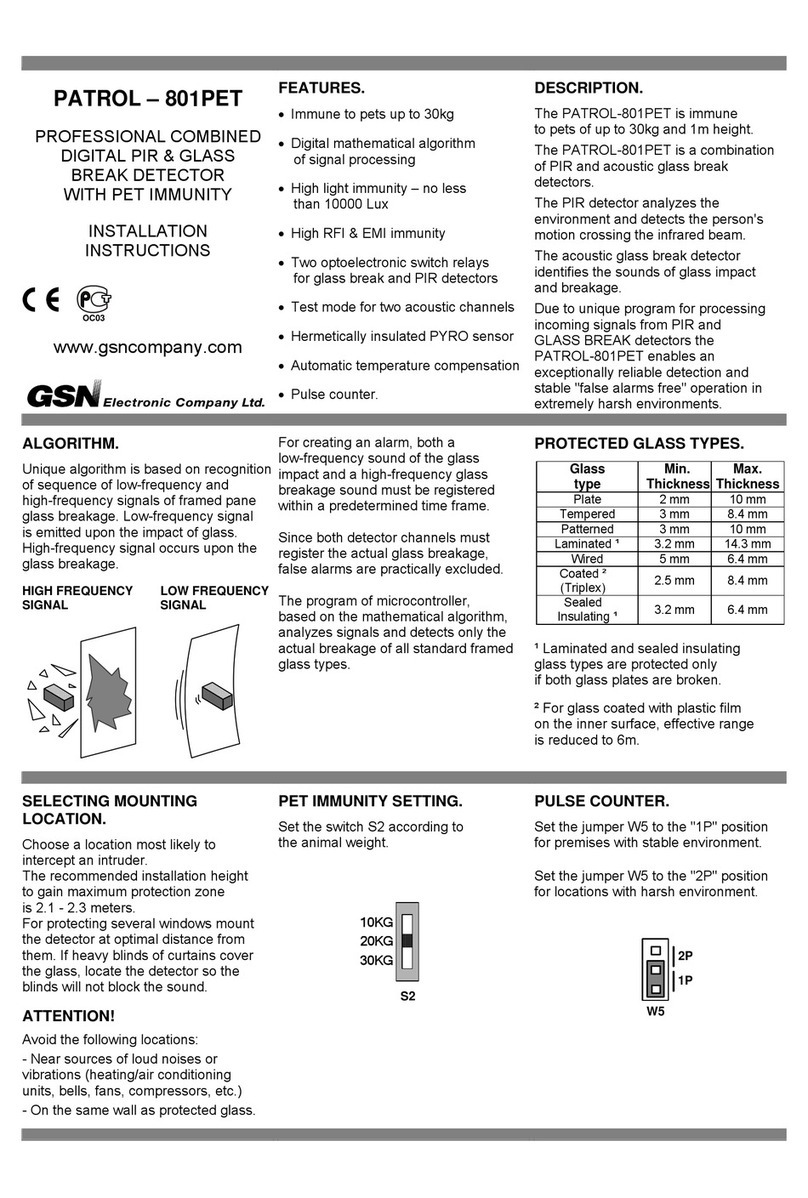
1 2 3 4 5
6 7 8 9 10
PATROL®- 803
COMBINED
PIR & GLASS
BREAK DETECTOR
INSTALLATION
INSTRUCTIONS
PATROL-803
The PATROL-803
is a combination of PIR and
acoustic glass break detector.
The PATROL-803 is a digital
passive infrared detector with
dual element pyrosensor,
which provides the most
efficient security of residential
and industrial premises.
The PIR detector analyzes
the environment and detects
the person's motion crossing
the infrared beam.
The acoustic glass break
detector identifies the sounds
of glass impact and breakage.
Two independent optoelectronic
relays of the PIR and glass break
detectors, allow connecting the
detectors to two independent
zones in the control panel.
FEATURES
•HI-TECH DESIGN
•DUAL TECHNOLOGY
PIR & MICROPHONE
•HIGH RFI & EMI IMMUNITY
•DIGITAL PROGRAM
ALGORITHM OF SIGNAL
PROCESSING
•PULSE COUNTER 1 or 2
•TEST MODE FOR TWO
ACOUSTIC CHANNELS
•INDIVIDUAL PIR SENSITIVITY
ADJUSTMENT
•HIGH LIGHT IMMUNITY
•HERMETICALLY SEALED
PYROELECTRIC SENSOR
•LOW OPERATING
TEMPERATURE
•AUTOMATIC TEMPERATURE
COMPENSATION
DETECTOR INSTALLATION
Fix the detector vertically
on solid, flat wall surface.
The installation height is
2 – 2.5 meters.
For corner or ceiling
installations, you can use
universal brackets – models:
"UBL-1112" or "UBL-1115."
(Additional purchase!)
For corner installation,
use knockouts located on the
sloping part of the detector
base.
For protecting several
windows, mount the detector
at optimal distance from them.
If heavy blinds of curtains
cover the glass, locate the
detector so the blinds will not
block the sound.
INSTALLATION
LIMITATIONS
•Do not install the detector on
unstable or vibrating surfaces.
•Do not install the detector
close to curtains, blinds or
other items that vibrate with
air movement.
•Do not install the detector
close to air conditioners, air
blast sources or above heat
sources.
•Do not install the detector
or route power wires and
alarm loops next to high
voltage cables.
TERMINAL BLOCK
CONNECTION
Connect the wires according
to the scheme.
+ 12V -TAMPER RELAY 1 RELAY 2
Terminals “+12V-“ - for
connection to the power supply
of the control unit.
Terminals “Tamper” - for
connection to a 24-hour
normally closed protective zone
in the control unit.
Terminals “Relay 1”- relay
output of the PIR detector.
Terminals “Relay 2”- relay
output of the glass break
detector.
DETECTOR ADJUSTMENT
1. Remove the front cover.
2. Select the required number
of pulses (1 or 2) using S2
regulator.
PIR
SENSITIVITY
1 PULSE
S2
2
1
PIR
SENSITIVITY
2 PULSE
S2
2
1
*Selectable pulse counter 1or 2
provides users with the option
of optimizing detector sensitivity
to suit the environment, thus
retaining reliable performance
at all times.
3. Connect the power and
wait for LED to stop flashing
(warm-up time 60 sec).
4. Replace the cover.
PATROL
803
J1
PIR
SENSITIVITY
+
W3
S1
R18
C18
D4
LED
SHOCK &
GLASS TEST
+
6M
9M
12M
W2
W1
OPERATING
MODE
GLASS TEST
GLASS
SENSITIVITY
ACOUSTIC
RANGE
ADJUSTMENT
+ 12V TAMPER RELAY 1 RELAY 2
R17
PULSE
S2
2
1
W1 – Jumper to select operating
and test modes.
W2 – Acoustic range adjustment
S2 – Pulse counter regulator
R17 – Glass sensitivity regulator
R18 – PIR sensitivity regulator
S1 – Tamper button
SELECTING COVERAGE
RANGE
Set the jumper W2 according
to the distance to the
protected glass.
RANGE
2
ADJUSTMENT
9m
6m
12m
ACOUSTIC
PROTECTED GLASS TYPES
Glass Type Min.
Thickness
Max.
Thickness
Plate 2 mm 14 mm
Tempered 3 mm 10 mm
Patterned 3 mm 12 mm
Laminated¹ 3.2 mm 14.3mm
Wired¹ 5 mm 6.4 mm
Coated (Triplex)¹ 2.5 mm 8.4 mm
Sealed insulating¹ 3.2 mm 6.4 mm
¹The detection range of the
acoustic glass break detector
is reduced up to 10 meters for
the following glass types:
Laminated, Wired, Coated
(Triplex), Sealed Insulating.
5. Pass in the field of view
detector. The RED LED
should actively respond to your
movement.
6. If necessary, increase the
detector PIR sensitivity,
using R18 potentiometer
“PIR Sensitivity”.
PIR
SENSITIVITY
+
R18
LED INDICATION ON
ALARM.
OFF
ON
OFF
ON
LED
W3
LED
W3
Jumper W3 will enable/disable
the alarm LED.
If W3 is ON – LED will operate
on alarm.
If W3 OFF – LED will
not operate on alarm.






























